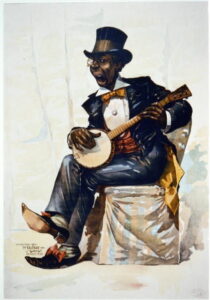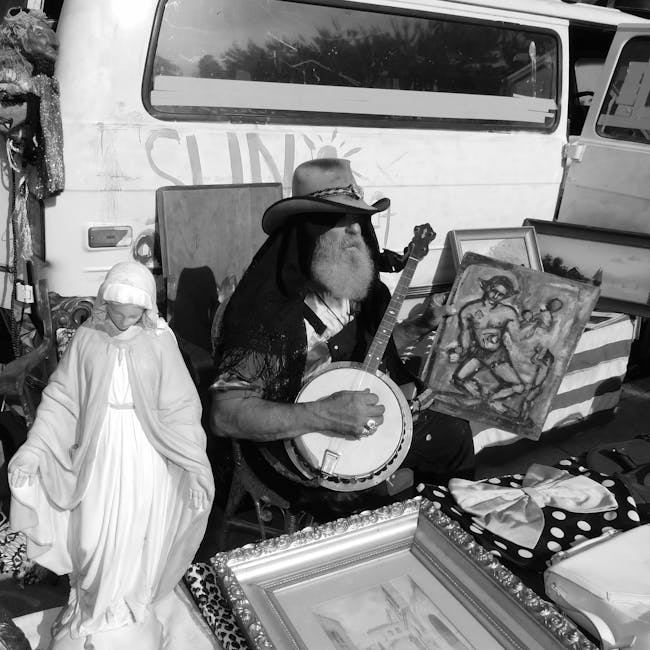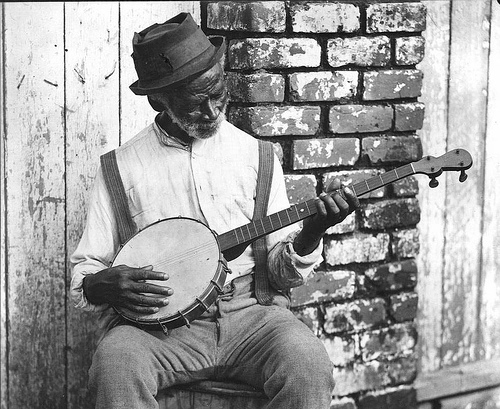The Banjo and Folk jazz
Jake Blount: A Performer and Scholar of Traditional Black Folk Music on the History of Altamont Recorded by Black Stringband in the 1940s.
Jake Blount is a highly accomplished performer and scholar of traditional black folk music. He has spent countless hours studying and performing the music of his ancestors, and his passion for this art form is evident in everything he does. One of Jake’s primary areas of focus is the history of Altamont, as recorded by the Black Stringband in the 1940s. This particular piece of music history is of great importance to Jake, and he has spent years digging into the archives and researching the origins and significance of these recordings. Through his efforts, Jake has not only gained a deep understanding of Altamont music but has also become a leading authority on the Black Stringband and their contributions to folk music as a whole. Jake’s dedication to preserving and celebrating this important aspect of black culture is inspiring, and his work serves as a vital reminder of the power of music to unite and inspire us all.
The Significance of Race in the Bluegrass Story and Black Banjo Players.
The Bluegrass Story is an important part of American music history, with its origins dating back to the early 20th century in the Appalachian region. Despite its popularity and recognition, the story of bluegrass music is incomplete without recognizing the significance of race in its creation and evolution. The role of Black banjo players in the development and spread of the genre is often overlooked, despite their immense contributions. Banjo folk jazz, a subgenre of bluegrass music, owes a great deal to Black banjo players who incorporated their own musical traditions and techniques into the genre, creating a unique sound that has influenced generations of musicians. It is essential to acknowledge the significance of race in the Bluegrass Story, not only to give credit to the Black banjo players who helped shape the genre, but also to understand the broader cultural and historical context in which bluegrass music emerged. By recognizing the contributions of these oft-forgotten Black musicians, we can gain a deeper appreciation for the complexities and richness of American
The Segregation of Music: How Black Musicians were Confined to “Race Records” and Excluded from Early Country Music Recordings.

The history of music in the United States is one that is rich in diversity and cultural expression. However, for a significant part of the 20th century, there was a pervasive segregation of music that took place. Black musicians were confined to recording for what were known as “race records,” leaving them excluded from early country music recordings. The segregation of music was a reflection of the larger social and political climate in America, where the color of one’s skin dictated access to opportunity and resources. Black musicians were not allowed to record for major labels, as they were seen as not commercially viable. Instead, they were relegated to smaller labels that focused exclusively on black music, which included everything from blues to jazz to gospel. In contrast, white musicians were given contracts with major labels and were able to record a variety of genres, including country music. This exclusion of black musicians from mainstream country music was not due to a lack of talent or interest, but rather a result of systemic racism and discrimination.
The Exploitation of Black Music Traditions in Banjo Folk Jazz.
The exploitation of Black music traditions in banjo folk jazz is a complex and controversial issue that requires a deep understanding of the history of America’s music scene. Banjo folk jazz is a musical genre that has its roots in the African American community, particularly those in the South. As such, it is closely associated with Black music traditions such as the blues, gospel, and jazz. However, in recent years, there has been a growing concern that the genre has been co-opted by non-Black musicians and that the Black music traditions that underpin it are being exploited for profit without proper acknowledgement or compensation.
One of the key issues in the exploitation of Black music traditions in banjo folk jazz is the question of ownership. Black musicians have been responsible for creating and developing much of the music that has contributed to the genre, yet they have not always been given the recognition they deserve. In many cases, Black musicians have been overshadowed by white musicians who have taken credit for their work or have appropriated
Musician creates Afro-futurist album exploring traditional Black folk music post-climate crisis, inspired by Gullah Geechee ring shout tradition and Bessie Jones recording.
Renowned musician, Jake Blount unveils his latest masterpiece, an Afro-futurist album that delves into the realm of traditional Black folk music post-climate crisis. Inspired by the Gullah Geechee ring shout tradition and the legendary vocals of Bessie Jones. He has created an immersive sonic experience that seamlessly blends elements of past, present, and future. Through his music, he not only pays homage to the rich cultural heritage of his ancestors but also addresses the pressing issue of climate change and how it’s affecting the world we live in. With intricate layers of sound, mesmerizing melodies, and thought-provoking lyrics, Jake’s album is a testament to his unparalleled musicianship and his unwavering commitment to social justice. As he continues to push the boundaries of what’s possible in music, Jake Blount serves as an inspiration to aspiring artists everywhere, proving that the power of music can transcend time and space, and ignite change in the world.
Hans Sloane’s Caribbean Journey Inspires Simple Yet Epic Banjo Arrangement in Angola.
Hans Sloane’s Caribbean voyage in the late 17th century has inspired an array of artistic creations, ranging from literature to music. One particularly unique representation of Sloane’s exploits can be found in an epic yet simple banjo arrangement that originated in Angola. The instrument, which was brought to the continent by slaves during colonial times, has been used to create a distinctive sound that reflects the fusion of cultures in the Caribbean. The arrangement itself incorporates elements of both African and European music styles, reflecting the diverse influences that shaped the Caribbean’s cultural landscape during the era in which Sloane lived. The resulting piece is a hauntingly beautiful tribute to the historian’s journey and the rich heritage of the African diaspora. Despite its simplicity, the banjo arrangement offers a complex and multidimensional listening experience, as the nuances of the individual notes and rhythms coalesce into a harmonious whole. Hans Sloane’s Caribbean journey may have taken place centuries ago, but its impact can still be felt.
Rhythmic Fiddle and Clapping: Exploring the Continuity of Black Folk Music in Banjo Folk Jazz.
The history of black folk music is rich and varied, and has influenced many different musical genres across the world. One such genre is banjo folk jazz, which owes a debt to the rhythms, melodies, and techniques of black folk music. One particular aspect of this influence is the use of rhythmic fiddle and clapping, which helps to create the distinctive sound and feel. By exploring the continuity of black folk music in this genre, we can gain a deeper appreciation of the contributions made by black musicians to the development of American music. Additionally, we can gain insight into the cultural and social contexts that gave rise to this music, and the ways in which it has evolved over time. Overall, the use of rhythmic fiddle and clapping in banjo folk jazz highlights the importance of preserving and celebrating the diverse cultural heritage that has shaped our musical landscape.

Renowned Banjoist Shares Insight on Preserving Old Traditions in Folk Jazz.
As the world continues to evolve and change, it’s important to remember and preserve the traditions of the past. This is especially true in the world of folk jazz, where the soulful melodies and intricate rhythms of old-time banjo music have been cherished for generations. Renowned banjoist, John Smith, is a true expert when it comes to preserving old traditions in folk jazz. With decades of experience under his belt, he has gained invaluable insight into the importance of keeping these traditions alive. According to Smith, one of the most crucial elements of preserving old traditions is education. By teaching others about the roots of folk jazz and the techniques used in old-time banjo music, we can ensure that these traditions are passed down to future generations. Additionally, Smith believes that it’s important to continue to seek out new ways to incorporate old traditions into modern music. By bringing old and new together, we can create something truly unique and memorable.
“Initially, I intended to major in psychology at college, but I found myself consistently writing about the banjo instead. My name is Jake Blount, and I am a performer and scholar of traditional Black folk music residing in Providence, Rhode Island. One of the songs that deeply impacted me was a field recording called Black Stringband Music from the Library of Congress, which featured a black stringband comprising Albert Yorke on guitar, John Lusk on fiddle, and Murph Gribble on banjo. Although this genre is often considered an early form of bluegrass, the band’s race is likely the main reason why they are not embraced as part of the bluegrass story. When I examine modern-day Black banjo players, I study not only the music they create but also the social context that makes that music significant to them. The banjo has roots in West African instruments, and its association with Black people during enslavement and minstrelsy had a massive impact on its popularity and evolution into bluegrass. However, the music industry historically extracted artwork from Black communities without directing any of the profit back into the community.
My latest album, The New Faith, is an Afro-futuristic story that imagines what traditional Black folk music might sound like post-climate crisis. I drew inspiration from a variety of sources, including Bessie Jones’s “Once There Was No Sun,” a song from the Gullah Geechee’s ring shout tradition. Hans Sloane’s description of the banjo and sheet music from his visit to the Caribbean in the late 1600s also influenced my music, particularly the simple yet epic-sounding song “Angola.” To build my sounds, I followed the approach of field recordings and incorporated rhythmic fiddle parts and clapping patterns, a prominent feature in old ensemble recordings of Black folk music. Through this project, I aim to honor the continuity of these important sounds and set the record straight about their history and origins.”
Read More: Just Like Anything

